Charles E W Bean, Diaries, AWM38 3DRL 606/237/1 - October 1914 - 1918 - Part 11
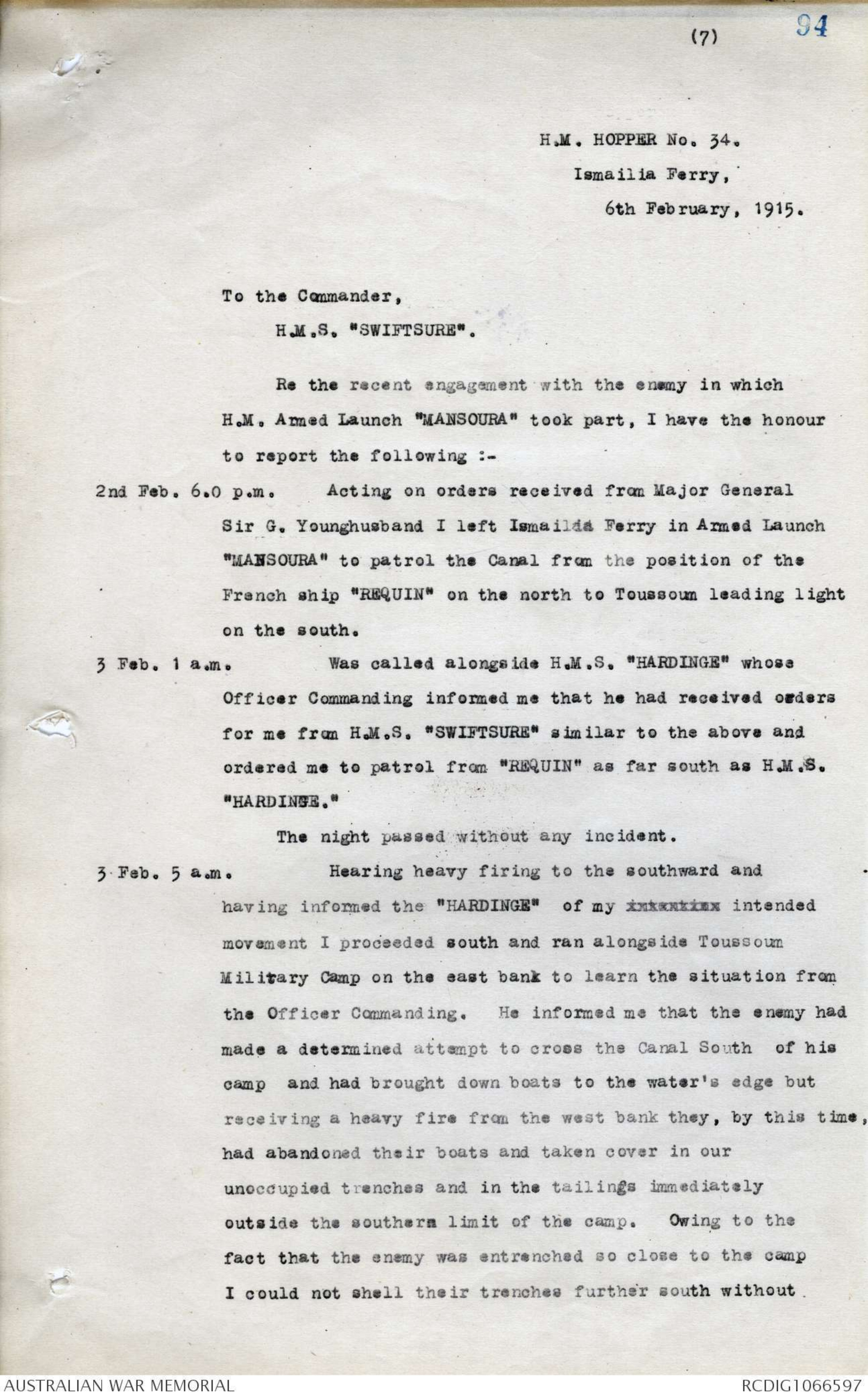
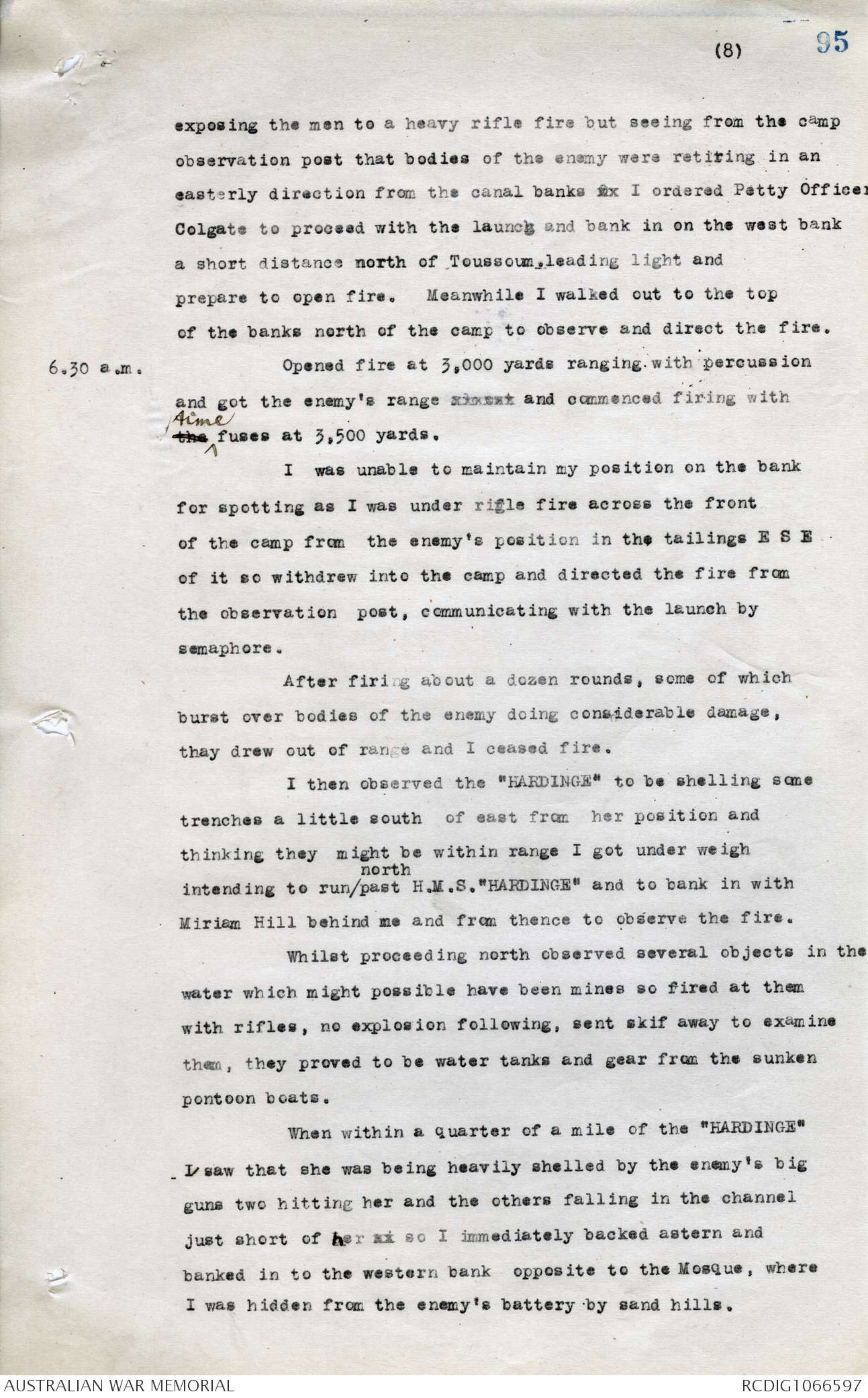


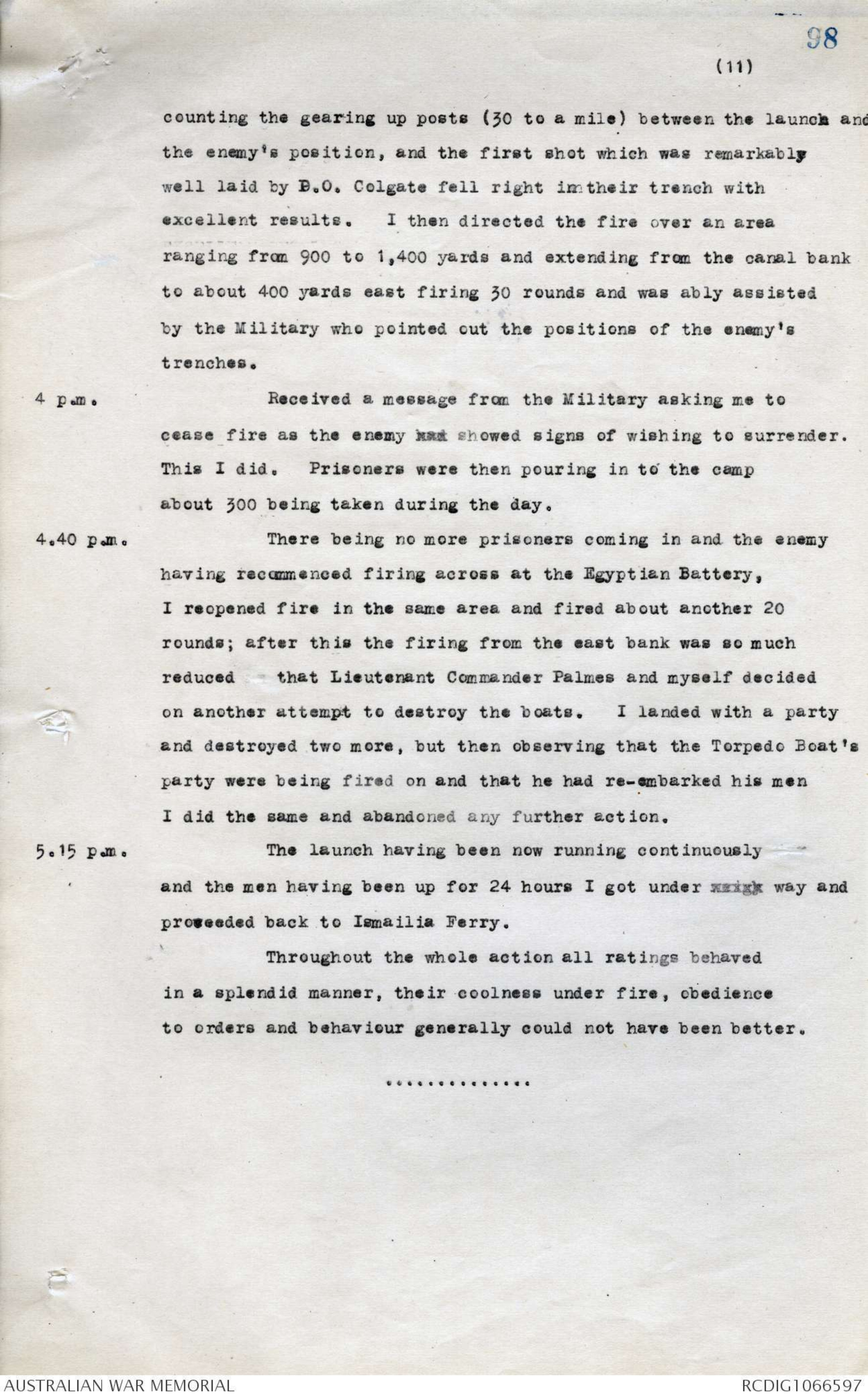
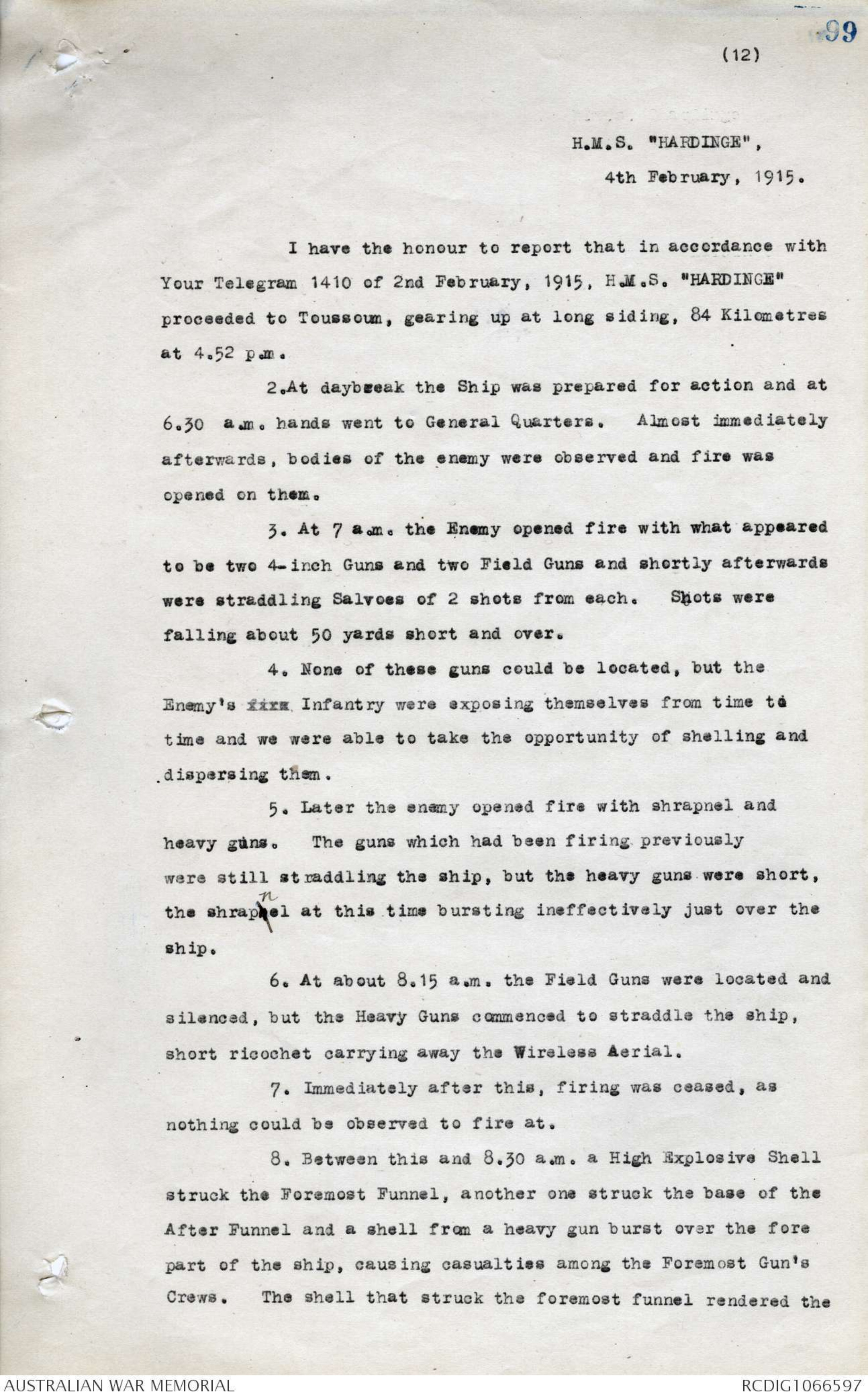
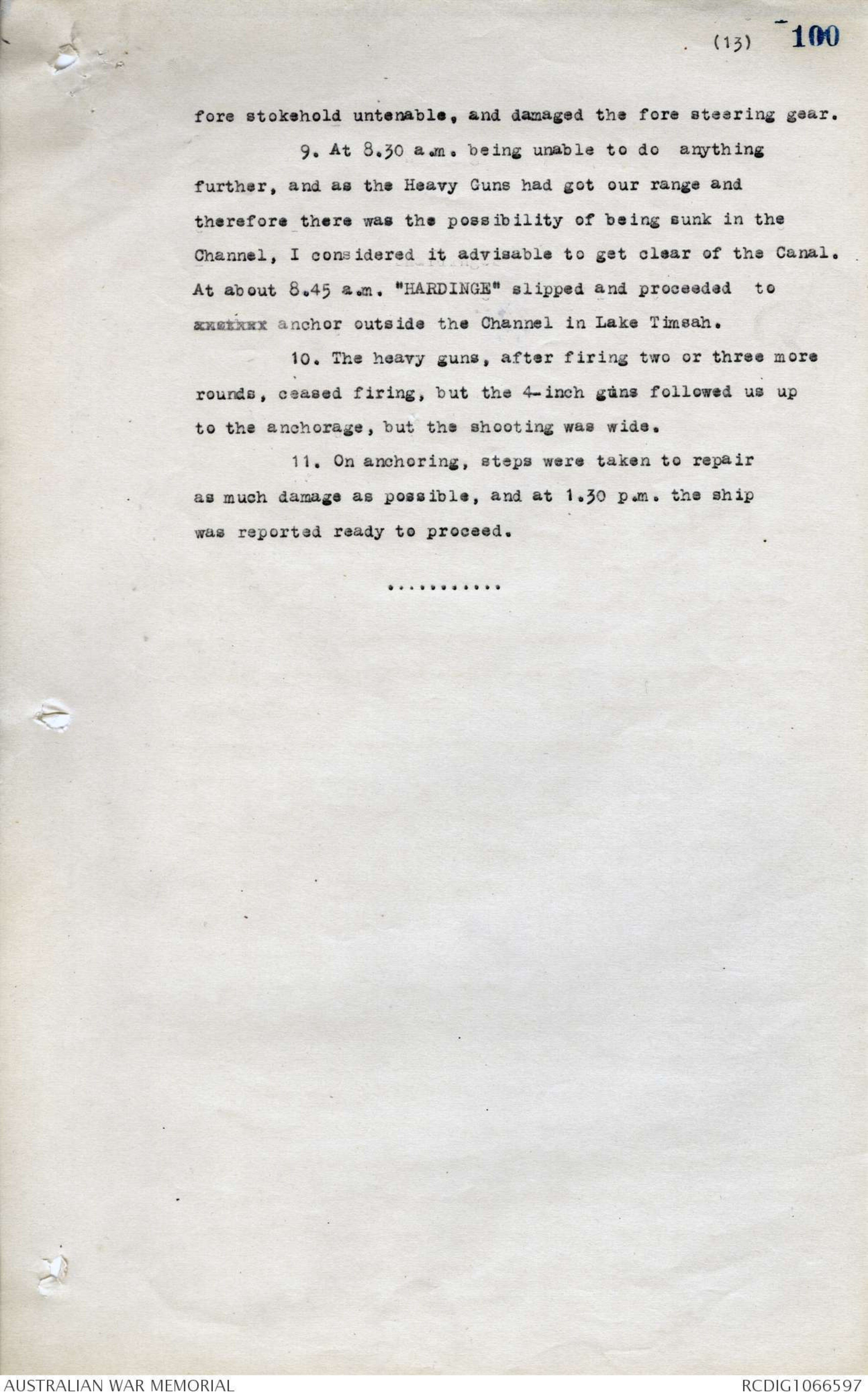
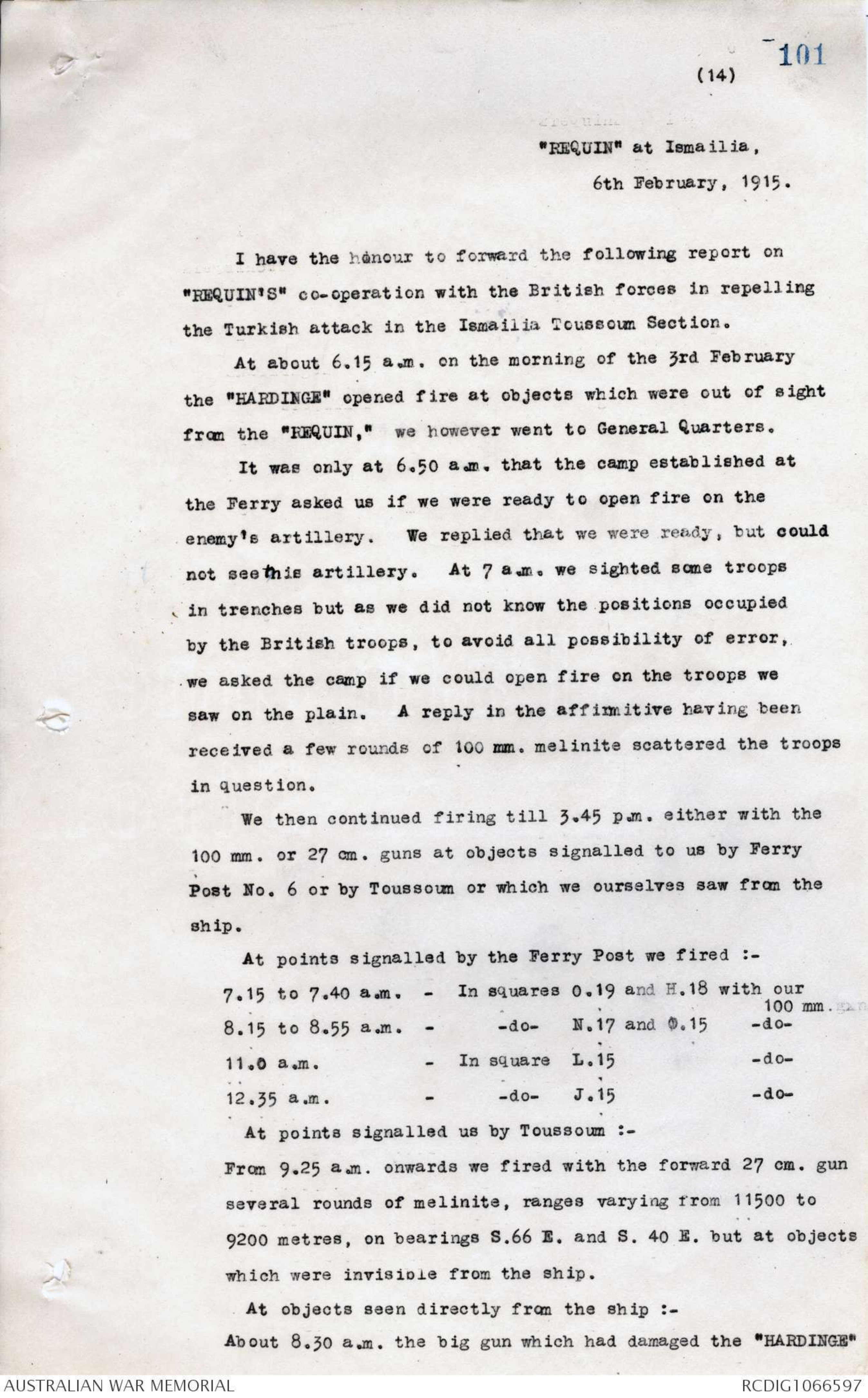
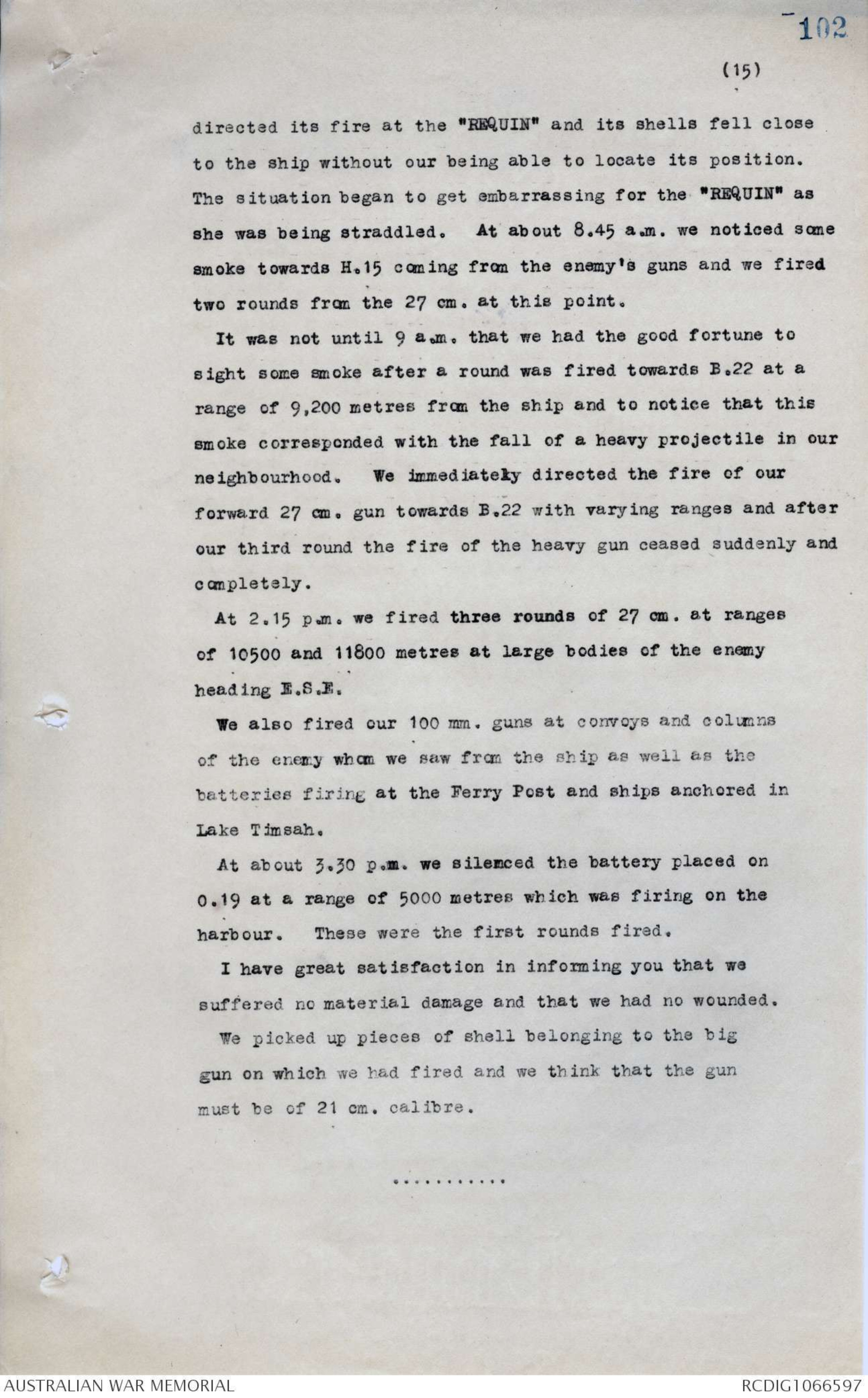
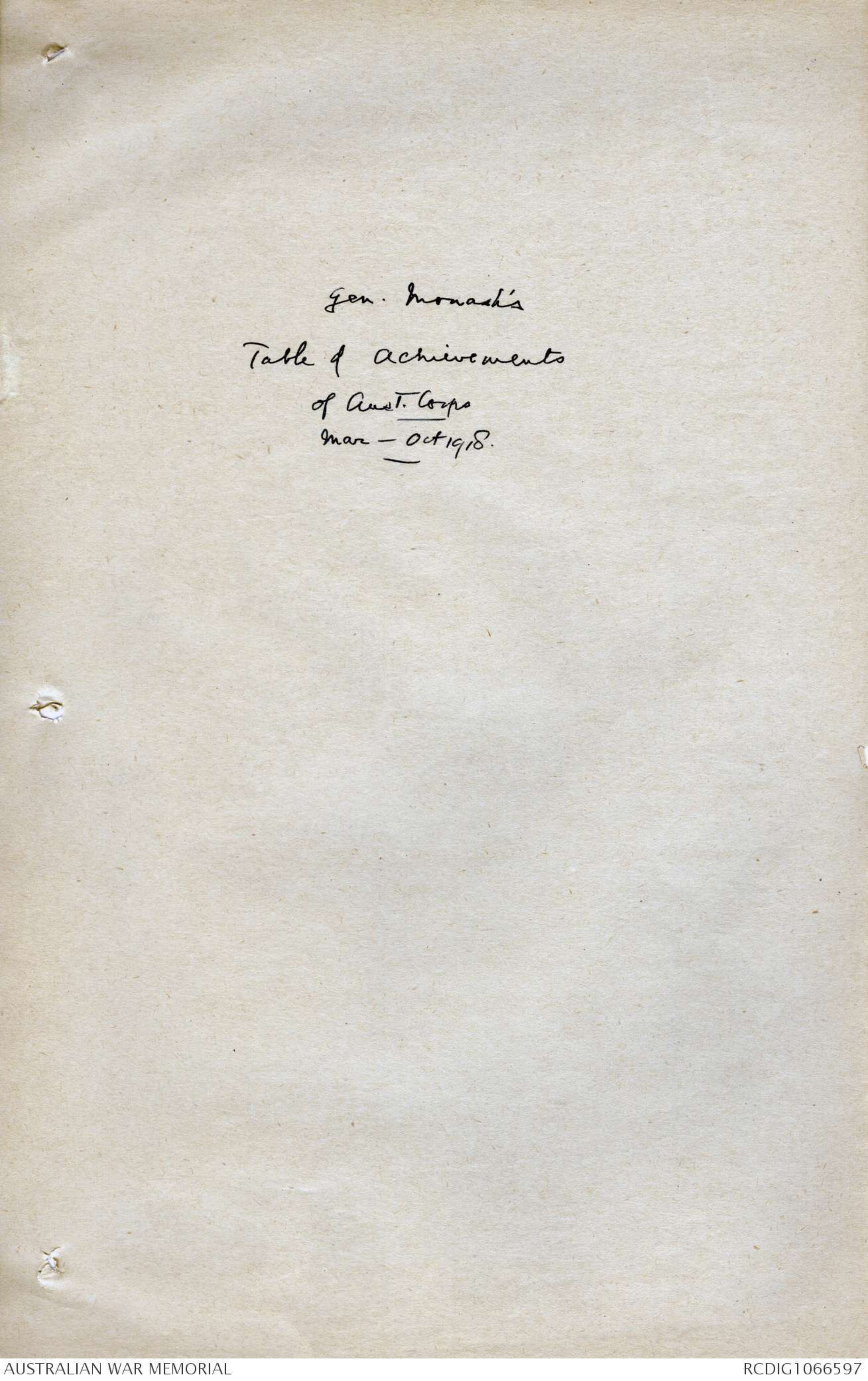
(7) 94
H.M. HOPPER No. 34.
Ismailia Ferry,
6th February, 1915.
To the Commander,
H.M.S. "SWIFTSURE".
Re the recent engagement with the enemy in which
H.M. Armed Launch "MANSOURA" took part, I have the honour
to report the following :-
2nd Feb. 6.0 p.m. Acting on orders received from Major General
Sir G. Younghusband I left Ismailia Ferry in Armed Launch
"MANSOURA" to patrol the Canal from the position of the
French ship "REQUIN" on the north to Toussoum leading light
on the south.
3 Feb. 1 a.m. Was called alongside H.M.S. "HARDINGE" whose
Officer Commanding informed me that he had received orders
for me from H.M.S. "SWIFTSURE" similar to the above and
ordered me to patrol from "REQUIN" as far south as H.M.S.
"HARDINGE."
The night passed without any incident.
3 Feb. 5 a.m. Hearing heavy firing to the southward and
having informed the "HARDINGE" of my intention intended
movement I proceeded south and ran alongside Toussoum
Military Camp on the east bank to learn the situation from
the Officer Commanding. He informed me that the enemy had
made a determined attempt to cross the Canal South of his
camp and had brought down boats to the water's edge but
receiving a heavy fire from the west bank they, by this time,
had abandoned their boats and taken cover in our
unoccupied trenches and in the tailings immediately
outside the southern limit of the camp. Owing to the
fact that the enemy was entrenched so close to the camp
I could not shell their trenches further south without
(8) 95
exposing the men to a heavy rifle fire but seeing from the camp
observation post that bodies of the enemy were retiring in an
easterly direction from the canal banks xx I ordered Petty Officer
Colgate to proceed with the launch and bank in on the west bank
a short distance north of Toussoum,leading light and
prepare to open fire. Meanwhile I walked out to the top
of the banks north of the camp to observe and direct the fire.
6.30 a.m. Opened fire at 3,000 yards ranging with percussion
and got the enemy's range xxxxx and commenced firing withthe ^time fuses at 3,500 yards.
I was unable to maintain my position on the bank
for spotting as I was under rifle fire across the front
of the camp from the enemy's position in the tailings E S E
of it so withdrew into the camp and directed the fire from
the observation post, communicating with the launch by
semaphore.
After firing about a dozen rounds, some of which
burst over bodies of the enemy doing considerable damage,
thay drew out of range and I ceased fire.
I then observed the "HARDINGE" to be shelling some
trenches a little south of east from her position and
thinking they might be within range I got under weigh
intending to run ^north past H.M.S."HARDINGE" and to bank in with
Miriam Hill behind me and from thence to observe the fire.
Whilst proceeding north observed several objects in the
water which might possible have been mines so fired at them
with rifles, no explosion following, sent skif away to examine
them, they proved to be water tanks and gear from the sunken
pontoon boats.
When within a quarter of a mile of the "HARDINGE"
I saw that she was being heavily shelled by the enemy's big
guns two hitting her and the others falling in the channel
just short of her xx so I immediately backed astern and
banked in to the western bank, opposite to the Mosque, where
I was hidden from the enemy's battery by sand hills.
(9) 96
Was informed by the Military post here that there were no
targets within my range, so got under weigh to proceed to
Serapeum, to learn the situation there from the Brigade
Headquarters.
Whilst passing Toussoum camp the Officer Commanding
warned me that the enemy held the east bank from his camp
to a distance of 1,500 yards south of it. I placed the men
below decks in the cabins fore and aft and from thence they
fired through the scuttles on the port side whenever an
opportunity offered. Petty Officer Colgate took the wheel,
I being with him beside inside the steel plating. Working the
engines up to their utmost speed, we reached Serapium
without any casualties notwithstanding a continuous fire over
a stretch of about 1,200 yards.
10 a.m. Fast alongside Serapium, sent hands to breakfast.
Met the Officer Commanding the Brigade and asked him if I
could shell enemy's position from the South, he thought not as
he was shortly sending out a counter attack but asked me to
do all I could to destroy the pontoon-boats and so prevent
a further attempt on the enemy's part to cross the canal
in the event of their being reinforced. I replied that I
would land where possible and destroy them, but could not
waste my shrapnel in shelling them. An enemy's battery had
now come into action firing four guns at a time with a slightly
different range on each, and were shelling with shrapnel the
precincts of the canal a half a mile north of Serapium
where one of our batteries was concealed in the trees.
On going aboard the launch I saw T.B.043, Lieut.
Commander Palmes approaching from the Bitter Lakes. I hailed
her xxxx and informed him of tbe heavy burst of shrapnel
ahead of him, he then stopped and we both banked in under
the lee of the eastern bank, he lying alongside me.
Our intentions were to wait here until the counter
attack had cleared the east bank of the enemy, when possibly
her battery might also have been silenced, and then to
(10) 97
proceed with the destruction of the boats. We heard later
though that the counter-attack was unable to advance further,
the enemy being in too great a force.
Noon. The enemy's shells were now bursting further south
and very near to us, so we decided to proceed south and as
T.B.043 was heading north I towed him alongside. Whilst
getting under way two salvos from their guns burst nearly over
us, and a shower of bullets landed on the decks, in "MANSOURA"
one man was hit on the arm, but it only caused a bruise, I
believe they detected us from the T.B's smoke. We found that
the reports of the guns being fired reached us a couple of
seconds before the shells, and so had time to take cover.
On arrival at Deversoir Lieutenant Commander Palmes
conversed with Headquarters Serapium on the telephone and we
were again asked to destroy the boats.
He and I then decided that, as their battery appeared
to concentrate their fire on our shore battery just north of
Serapium, we might run through the zone of fire and get at
those boats nearest to Toussoum Camp.
This we proceeded to do at as great speed as possible,
my crew again being below and firing through the scuttles; the
enemy's battery undoubtedly again detected the Torpedo Boat's
smoke as we drew their fire from south of Serapium up to
Toussoum.
I here lay the "MANSOURA" alongside and was informed
by the Officer Commanding of the camp that he was driving the
enemy out of the ground south of his camp and had taken many
prisoners, this enabled me to have destroyed at once a boat
which was lying about 200 yards in from the canal bank; this
was done with axes and a heavy top maul.
3 p.m. Shortly afterwards observed several of the enemy in
a trench on top of the canal bank 1,000 yards south of us, and
the Military having by now cleared the ground for a distance
of about 500 yards south of the camp was able to open fire with
the 12-pdr. with direct aim. xx I took off the range by
(11) 98
counting the gearing up posts (30 to a mile) between the launch and
the enemy's position, and the first shot which was remarkably
well laid by B.O. Colgate fell right in their trench with
excellent results. I then directed the fire over an area
ranging from 900 to 1,400 yards and extending from the canal bank
to about 400 yards east firing 30 rounds and was ably assisted
by the Military who pointed out the positions of the enemy's
trenches.
4 p.m. Received a message from the Military asking me to
cease fire as the enemy had showed signs of wishing to surrender.
This I did. Prisoners were then pouring in to the camp
about 300 being taken during the day.
4.40 p.m. There being no more prisoners coming in and the enemy
having recommenced firing across at the Egyptian Battery,
I reopened fire in the same area and fired about another 20
rounds; after this the firing from the east bank was so much
reduced that Lieutenant Commander Palmes and myself decided
on another attempt to destroy the boats. I landed with a party
and destroyed two more, but then observing that the Torpedo Boat's
party were being fired on and that he had re-embarked his men
I did the same and abandoned any further action.
5. 15 p.m. The launch having been now running continuously
and the men having been up for 24 hours I got under weigh way and
proceeded back to Ismailia Ferry.
Throughout the whole action all ratings behaved
in a splendid manner, their coolness under fire, obedience
to orders and behaviour generally could not have been better.
(12) 99
H.M.S. "HARDINGE"
4th February, 1915.
I have the honour to report that in accordance with
Your Telegram 1410 of 2nd February, 1915, H.M.S. "HARDINGE"
proceeded to Toussoum, gearing up at long siding, 84 Kilometres
at 4.52 p.m.
2.At daybreak the Ship was prepared for action and at
6.30 a.m. hands went to General Quarters. Almost immediately
afterwards, bodies of the enemy were observed and fire was
opened on them.
3. At 7 a.m. the Enemy opened fire with what appeared
to be two 4-inch Guns and two Field Guns and shortly afterwards
were straddling Salvoes of 2 shots from each. Shots were
falling about 50 yards short and over.
4. None of these guns could be located, but the
Enemy's fire Infantry were exposing themselves from time to
time and we were able to take the opportunity of shelling and
dispersing them.
5. Later the enemy opened fire with shrapnel and
heavy guns. The guns which had been firing previously
were still straddling the ship, but the heavy guns were short,
the shrapnel at this time bursting ineffectively just over the
ship.
6. At about 8.15 a.m. the Field Guns were located and
silenced, but the Heavy Guns commenced to straddle the ship,
short ricochet carrying away the Wireless Aerial.
7. Immediately after this, firing was ceased, as
nothing could be observed to fire at.
8. Between this and 8.30 a.m. a High Explosive Shell
struck the Foremost Funnel, another one struck the base of the
After Funnel and a shell from a heavy gun burst over the fore
part of the ship, causing casualties among the Foremost Gun's
Crews. The shell that struck the foremost funnel rendered the
(13) 100
fore stokehold untenable, and damaged the fore steering gear.
9. At 8.30 a.m. being unable to do anything
further, and as the Heavy Guns had got our range and
therefore there was the possibility of being sunk in the
Channel, I considered it advisable to get clear of the Canal.
At about 8.45 a.m. "HARDINGE" slipped and proceeded toanother anchor outside the Channel in Lake Timsah.
10. The heavy guns, after firing two or three more
rounds, ceased firing, but the 4-inch guns followed us up
to the anchorage, but the shooting was wide.
11. On anchoring, steps were taken to repair
as much damage as possible, and at 1.30 p.m. the ship
was reported ready to proceed.
(14) 101
"REQUIN" at Ismailia,
6th February, 1915.
I have the honour to forward the following report on
"REQUIN'S" co-operation with the British forces in repelling
the Turkish attack in the Ismailia Toussoum Section.
At about 6.15 a.m. on the morning of the 3rd February
the "HARDINGE" opened fire at objects which were out of sight
from the "REQUIN," we however went to General Quarters.
It was only at 6.50 a.m. that the camp established at
the Ferry asked us if we were ready to open fire on the
enemy's artillery. We replied that we were ready, but could
not see this artillery. At 7 a.m. we sighted some troops
in trenches but as we did not know the positions occupied
by the British troops, to avoid all possibility of error,
we asked the camp if we could open fire on the troops we
saw on the plain. A reply in the affirmitive having been
received a few rounds of 100 mm. melinite scattered the troops
in question.
We then continued firing till 3.45 p.m. either with the
100 mm. or 27 cm. guns at objects signalled to us by Ferry
Post No. 6 or by Toussoum or which we ourselves saw from the
ship.
At points signalled by the Ferry Post we fired:-
7.15 to 7.40 a.m. - In squares O.19 and H.18 with our 100 mm.
8.15 to 8.55 a.m. - -do- N.17 and O.15 -do-
11.0 a.m. - In square L.15 -do-
12.35 a.m. - -do- J.15 -do-
At points signalled us by Toussoum :-
From 9.25 a.m. onwards we fired with the forward 27 cm. gun
several rounds of melinite, ranges varying from 11500 to
9200 metres, on bearings S.66 E. and S. 40 E. but at objects
which were invisible from the ship.
At objects seen directly from the ship :-
About 8.30 a.m. the big gun which had damaged the "HARDINGE"
(5) 102
directed its fire at the "REQUIN" and its shells fell close
to the ship without our being able to locate its position.
The situation began to get embarrassing for the "REQUIN" as
she was being straddled. At about 8.45 a.m. we noticed some
smoke towards H.15 coming from the enemy's guns and we fired
two rounds from the 27 cm. at this point.
It was not until 9 a.m. that we had the good fortune to
sight some smoke after a round was fired towards B.22 at a
range of 9,200 metres from the ship and to notice that this
smoke corresponded with the fall of a heavy projectile in our
neighbourhood. We immediately directed the fire of our
forward 27 cm. gun towards B.22 with varying ranges and after
our third round the fire of the heavy gun ceased suddenly and
completely.
At 2.15 p.m. we fired three rounds of 27 cm. at ranges
of 10500 and 11800 metres at large bodies of the enemy
heading E.S.E.
We also fired our 100 mm. guns at convoys and columns
of the enemy whom we saw from the ship as well as the
batteries firing at the Ferry Post and ships anchored in
Lake Timsah.
At about 3.30 p.m. we silenced the battery placed on
O.19 at a range of 5000 metres which was firing on the
harbour. These were the first rounds fired.
I have great satisfaction in informing you that we
suffered no material damage and that we had no wounded.
We picked up pieces of shell belonging to the big
gun on which we had fired and we think that the gun
must be of 21 cm. calibre.
Gen. Monash's
Table of Achievements
of Aust. Corps
Mar - Oct 1918.
 Sam scott
Sam scottThis transcription item is now locked to you for editing. To release the lock either Save your changes or Cancel.
This lock will be automatically released after 60 minutes of inactivity.